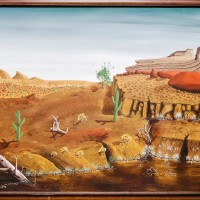-
Strange Cases of Authentication: When Is the Artist's Word Enough?
08/04/2016
 Two pending cases present opposite but equally curious issues of art authentication by a living artist. In one, the artist Peter Doig is being sued because he disavowed authorship of a work that a collector says is by Doig; in the other, an artist claims authorship over works that another man claims to have forged. Both cases pose interesting questions about who, if not the artist, is the final say on whether an artwork is by the artist’s hand.
Two pending cases present opposite but equally curious issues of art authentication by a living artist. In one, the artist Peter Doig is being sued because he disavowed authorship of a work that a collector says is by Doig; in the other, an artist claims authorship over works that another man claims to have forged. Both cases pose interesting questions about who, if not the artist, is the final say on whether an artwork is by the artist’s hand.
Fletcher v. Doig, 13-cv-03270 (N.D. Ill.)
Robert Fletcher is the owner of a desert landscape he claims was painted by famed Scottish artist Peter Doig, but Doig has denied that the work is his. Fletcher has sued Doig, seeking damages based on the impact of Doig’s statements on the value of the work, and asking for a declaratory judgment that Doig created the work.
The facts of this case harken back to Doig’s teenage years: Fletcher claims to have purchased the painting for $100 from Doig in 1975 while Fletcher was working as a corrections officer at a facility in Thunder Bay, Ontario, where he claims Doig was an inmate. When Fletcher learned decades later that the work he had purchased might be by Doig (whose market by that point was already robust), he consigned the painting to the Bartlow Gallery in Chicago, which in turn consigned the painting to Leslie Hindman Auctioneers. Doig, for his part, disavowed the work, and the painting was not offered for sale.
In his motion for summary judgment, Doig not only argued that he had not created the work, but presented evidence that another man, Peter Doige, was the true painter. Doige (now deceased) had been imprisoned at Thunder Bay in 1975, and painted during his incarceration. This theory was supported by testimony from Mr. Doige’s sister and from the prison’s former art teacher. The Court found Doig’s evidence insufficient to disprove that he was the author of the painting, and denied Doig’s motion for summary judgment. A bench trial is scheduled for August 8, 2016. Both sides will present “expert” testimony regarding the authenticity of the work. (Bartlow has already created a series of videos comparing the work to other Doig paintings.) Meanwhile, the art world is discussing the curious notion that an artist will need to prove he did not create a work.
Lee Ufan and the Hyeon Forgeries
A year-long investigation into the forgery of works purported to be by South Korean artist Lee Ufan has wound up with a strange result: experts have determined the works to be forgeries, the forger has confessed to forging the works, but Lee himself avers that the works are his.
This May, South Korean authorities seized 13 alleged forgeries, and arrested a gallery owner, among others, for forging works purporting to be by Lee. The gallery owner, Hyeon, admitted to having made dozens of replicas of Lee paintings, including three of the 13 seized works. These works were examined by forensic experts, who concluded that the three Hyeon works were indeed forgeries. As the Korea Herald reports, Hyeon has been convicted twice of copying Korean artists, once in 1991 and again in 1995.
What seemed like an open-and-shut case against Hyeon was complicated when Lee was asked by Seoul Metropolitan Police Agency’s Intellectual Crime Investigation Squad to analyze the works. According to reports in the Korea Times, Lee claimed that all 13 pieces were his: “The use of color, rhythm and breathing are all mine.” Despite Lee’s avowal that the works are authentic, the police have continued their investigation. Lee, for his part, has since opined that a living artist’s opinions should be given priority, and criticized police for not involving him sooner (having only been brought in to view the works after the investigation and arrest of the confessed forger, Hyeon). In the meantime, Artifex Press has announced that it will publish a catalogue raisonné of Lee’s works; as a publication date has not yet been announced, it remains to be seen how the catalogue will address the alleged forgeries. Just as it is uncertain whose word will prevail in the case against Hyeon and other accused forgers.
Authorship Disputes Can Arise Even When a Work is By a Living Artist
With the art world still reeling from the Knoedler forgery scandal, authentication of artwork is a hot topic. But as these cases show, even a living artist’s word may not be dispositive. Other evidence and testimony, including analysis by forensic experts, may also sway opinion about a work’s attribution. And while this blog has written before about an artist’s rights, under certain circumstances, to disavow a work she actually created, for reasons such as a deteriorated condition, the Doig case presents a different issue, where the artist denies having created it at all. And where an artist seeks to disavow a work, she may risk fighting a protracted (and expensive) litigation; and, as VeneKlasen noted in an interview with the New York Times, an artist who lacks sufficient resources to fight such battles may effectively be forced to allow works into the market that bear her name, but which she did not create.
We will update this blog as the Lee forgery investigation unfolds, and when the Doig trial moves forward next month.
Art Law Blog
